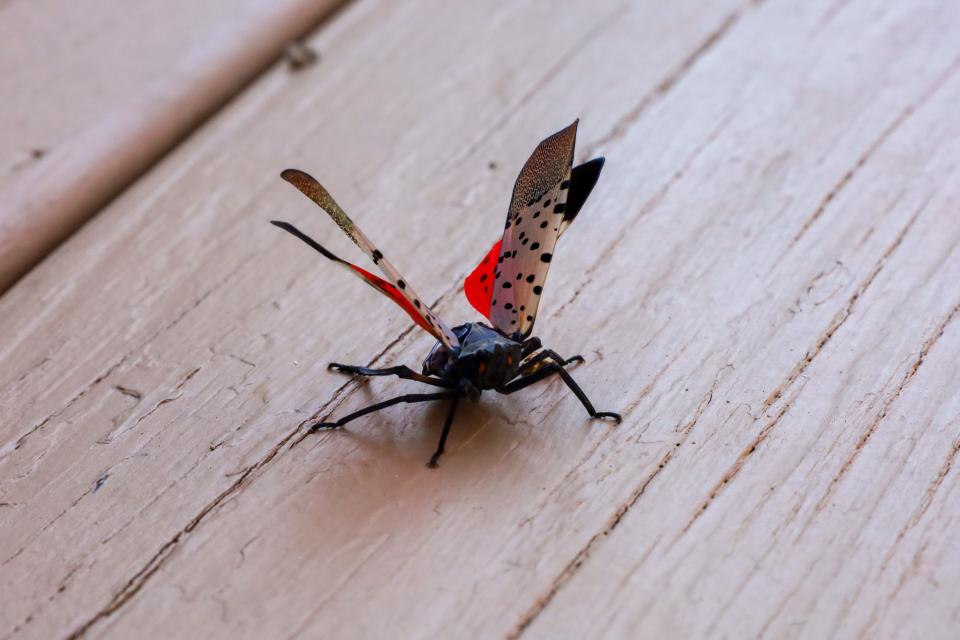Ken Baker: Lanternflies are a growing threat to fruit and other plants
There’s a cartoon in the Oct. 2 New Yorker of a gray, croissant-shaped insect standing on a stage before an audience of others of its kind. From the patch of bright red on its hind wings, the only color in the toon, you’re meant to know the speaker is a spotted lanternfly. She’s pointing to a screen at a picture of you.
“They’re an invasive species that will destroy the environment if left unchecked.”
The bug’s got a point.

Zebra mussels and round gobies from Europe may have reworked Lake Erie’s ecosystem, and the emerald ash borer from Asia eliminated white and green ashes from urban streets and forests across Eastern North America, but perhaps your life hasn’t been directly affected.
That seems likely to change
Colorful pests are spreading through Eastern Ohio
In this first of a two-part series on the spotted lanternfly (Lycorma delicatula), I’ll share some of what we’ve learned about this problematic pest since it was first discovered in Berks County in southeastern Pennsylvania in 2014. In the follow-up piece, we’ll consider the tricky question of what the future may hold.
Despite their name, lanternflies don’t emit light and aren’t flies, although they are indeed spotted. Because their wings fold, tentlike, over their backs, they are often mistaken for miniature moths, but that’s wrong too.
Rather, they belong to a group of “True Bugs” (Order Hemiptera) known by the unlovely but appropriately descriptive name, planthoppers. Over 12,500 species have been named, most of which live in the tropics. In all species, both the larval and adult stages feed by sucking plant sap through a straw-like proboscis.
To give the devil his due, spotted lanternflies, SLF for short, are stunningly attractive insects. About an inch long and a half-inch wide, adults have two pairs of wings. The front wings (which cover the back when feeding) are a soft grayish-brown with black spots speckling the front two-thirds and 50 or so narrow rows of black dashes at the back.
When disturbed, they flash their hindwings which feature a startling red at the base and a black tip separated by a thick white band. Interesting thing about that “startling” red: It’s a warning to potential predators that they taste bad. And, oddly enough, it may play a role in our ability to manage their populations.

Lanternflies feed on more than 170 species of plants
I’ll get to that in the follow-up essay, but for now, let’s look at why they’ve proven such a problem, and not just in our backyards. Worldwide, they’ve been shown to feed on more than 170 species of plants including, of greatest concern to many, grape vines, fruit trees, ornamental and woody trees.
A few planthoppers aren’t a big deal, but the SLF has no natural predators in North America and populations can number in the thousands on a single plant, with each individual pulling sugary sap from its host’s stem or trunk, fluids which the plant requires for its own maintenance and growth.
Actually, the sap is too sugary and lanternflies are almost constantly excreting sticky, partially digested sap in a form euphemistically called honeydew. This builds up on anything below and serves as an ideal food for sooty black mold, a fungus that can spoil fruit, attract bees and wasps, and interfere with a plant’s photosynthesis.
SLF is native to China, Vietnam and Bangladesh, where native parasites seem to keep it pretty well in check. But its mode of reproducing almost guaranteed it would eventually find its way to other parts of the world.
After hatching in late April-May, the nymphs (larvae) pass through four instars (stages) before morphing into reproductive adults in July. Mating occurs from late September to early winter when they die. The problem is that the females lay their 1.5-inch long mass of about 30 eggs on almost any smooth surface including tree trunks, lawn furniture, buildings and, most troubling, cars, trucks and trains.
Since lanternflies are weak fliers, researchers believe modes of transportation are the chief means by which SLF has spread, first from China to South Korea and Japan, and then to the U.S. Infestations are now found in 14 states in the Mid-Atlantic, Northeast, and Midwest. And it continues to spread.
They were first detected in Eastern Ohio in 2020 and are now firmly established in eight counties. In Toledo, their populations have seen exponential increases over each of the past several years.
While early nymphal stages commonly feed on a wide variety of herbaceous plants (that’s where grape growers’ concerns lie), late instar nymphs and adults usually find their way a woody tree. Although they will feed on a wide variety of species including black walnuts, red maples and many types of fruit trees, adults very much prefer another invasive from Asia, the Tree-of-heaven or Ailanthus, which is now found in disturbed soils throughout much of the country.
In a 2022 study, researchers developed a model predicting that, without effective preventative management, lanternflies will likely reach California with its multibillion-dollar fruit industry by 2033. So, what about preventative management?
Next time.
Ken Baker is a retired professor of biology and environmental studies. If you have a natural history topic you would like Dr. Baker to consider for an upcoming column, please email your idea to fre-newsdesk@gannett.com.
This article originally appeared on Fremont News-Messenger: Ken Baker: Don't let the spotted lanternfly's good looks fool you

